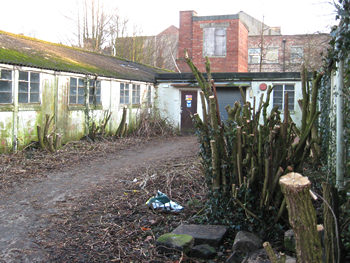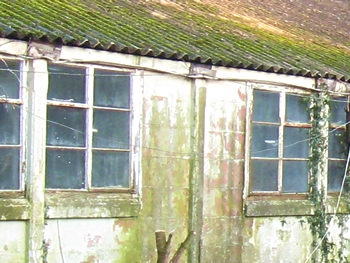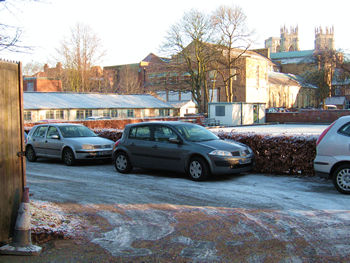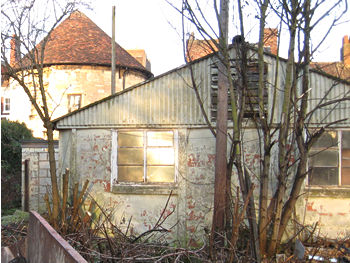August 2011

A rare survival on a city centre site
These rather dilapidated buildings would have been bulldozed if the plans for the ‘big wheel‘ had gone ahead, and have won only a temporary reprieve. There are plans to landscape the area and remove them, possibly as early as autumn 2011.
The earlier planning application called them ‘hutments’ (a term used for military-related encampments). They date from the Second World War, and look like other buildings from that period. In themselves they’re not architecturally impressive. What’s unusual about them is their location and their original purpose. What’s worrying is that they may be demolished when only a few people have any idea of their history. Most people don’t know we’ve got a former Second World War RCAF hostel behind the art gallery.
These ‘hutments’ have managed to survive in a quiet corner in our city centre for almost 70 years. They’ve had a variety of uses since their hurried construction, but were originally a service hostel or ‘leave club’ for the Royal Canadian Air Force.
‘Your Committee have agreed to raise no objection to the requisitioning by the Ministry of Works of a site at the rear of the Art Gallery for use as a Leave Club for members of the Royal Canadian Air Force, subject to certain details which they have authorised the Town Clerk, City Engineer and Curator to settle.’
– Art Gallery Committee, February 1944 (York City Council minutes)
Canadian bomber crews served at several local airfields, most now crumbling away into the landscape, including East Moor (near Sutton on the Forest) and Tholthorpe.
A letter sent to the Yorkshire Air Museum, with accompanying photographs, records that this service hostel/leave club was used by members of the RCAF when returning from leave, or if they’d missed the last bus or train, or were changing postings, or had a few days spare before they were due on base.

The buildings are seen by most as an eyesore, to be cleared as soon as possible. To others they’re an authentic link to our wartime history and should be preserved, at least in part. A report submitted among the supporting documents with the planning application called them a ‘a rare and interesting survival within an urban context’. Because of this, there’s a ‘recording exercise’ taking place before they’re demolished. This is intended as some kind of compensation to the future generations, or indeed members of the present generations, who might have been interested in this heritage asset we’re about to clear out of the way, so they can see photos of it when it’s gone, rather than looking around it while it’s here.
They’re not beautiful, they’re functional. Or they were, before a lack of maintenance left them in this dilapidated state. In themselves they have no architectural merit. But it would appear that they are the only surviving purpose-built service hostel/leave club dating from World War Two still in existence in a city centre location. If you know of others, please let me know.

References on urban exploration forums and a recent letter to the local paper show there’s some confusion regarding what the buildings were used for, and who used them. Not surprising really. Their history hasn’t been advertised. Which is why I’ve included so much about them on this website.
This area is destined to be cleared, to become part of the ‘Cultural Quarter’. The current structures are clearly a bit too gritty, grubby and authentic to be ‘cultural’. So instead this is to be another garden area (which could equally well be sited on that other underused area just north of the abbey remains).

Here’s a bit of real history, right in our backyard, and it’s seen as having little value. Close by are St Mary’s Tower, damaged during an earlier conflict, and the grounds where besiegers and besieged fought.
So, in this small corner of York are the visible remains of the two major conflicts that have affected this city in recent centuries. One has no marker since the plaque on St Mary’s Tower fell off. The other is represented by this surviving structure that York Museums Trust want to clear away without most of us having the chance to see it, never mind understand it.
Location
Map showing an aerial view of the ‘hutments’ site
Enlarge the map
More
History of the hutments – notes on the wartime and post-war use of these buildings
And also – Marygate Centre – notes/dates re the use of the buildings for adult education, post-war
If you’re looking for views of the interior, a search for ‘hutments York’ in Google will show that several urban explorers/’guerilla historians’ have been undertaking recording exercises of their own. Thanks to them for capturing artistic and authentic images of a forgotten place. As for me, I just got some rather poor images of the exterior, on a few cold days in winter.
Though I can offer a few classy black and white images of the interior, taken many decades ago.
. . . . . .
Update: the buildings were demolished in 2011-12.





Thank you for adding a comment. Please note that comments are moderated, but should appear within 24 hours.